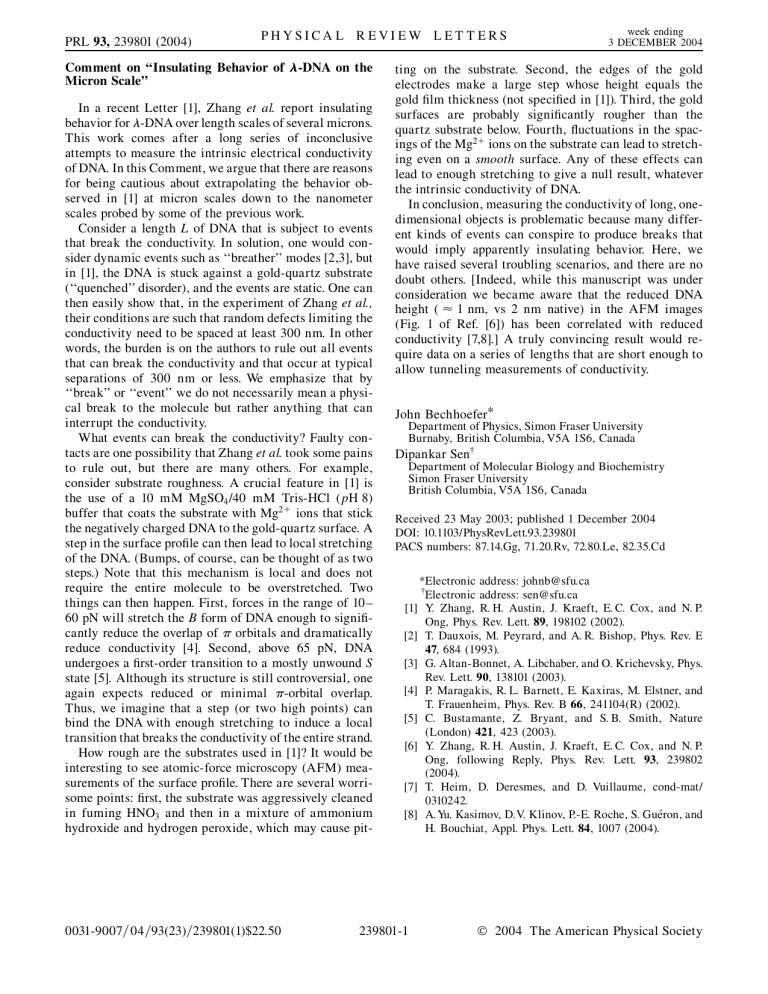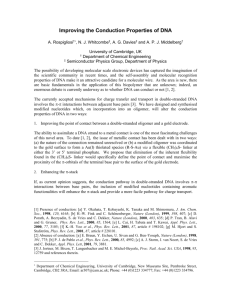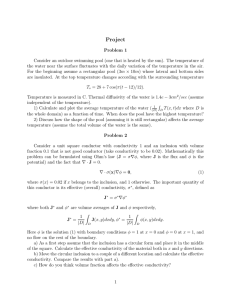Micron Scale’’ electrodes make a large step whose height equals the

PRL 93, 239801 (2004)
P H Y S I C A L R E V I E W
Comment on ‘‘Insulating Behavior of -DNA on the
Micron Scale’’
In a recent Letter [1], Zhang behavior for
Consider a length L et al.
report insulating
-DNA over length scales of several microns.
This work comes after a long series of inconclusive attempts to measure the intrinsic electrical conductivity of DNA. In this Comment, we argue that there are reasons for being cautious about extrapolating the behavior observed in [1] at micron scales down to the nanometer scales probed by some of the previous work.
of DNA that is subject to events that break the conductivity. In solution, one would consider dynamic events such as ‘‘breather’’ modes [2,3], but in [1], the DNA is stuck against a gold-quartz substrate
(‘‘quenched’’ disorder), and the events are static. One can then easily show that, in the experiment of Zhang et al., their conditions are such that random defects limiting the conductivity need to be spaced at least 300 nm. In other words, the burden is on the authors to rule out all events that can break the conductivity and that occur at typical separations of 300 nm or less. We emphasize that by
‘‘break’’ or ‘‘event’’ we do not necessarily mean a physical break to the molecule but rather anything that can interrupt the conductivity.
What events can break the conductivity? Faulty contacts are one possibility that Zhang et al.
took some pains to rule out, but there are many others. For example, consider substrate roughness. A crucial feature in [1] is the use of a 10 mM MgSO
4
/40 mM Tris-HCl ( buffer that coats the substrate with Mg 2 p H 8 ) ions that stick the negatively charged DNA to the gold-quartz surface. A step in the surface profile can then lead to local stretching of the DNA. (Bumps, of course, can be thought of as two steps.) Note that this mechanism is local and does not require the entire molecule to be overstretched. Two things can then happen. First, forces in the range of 10 –
60 pN will stretch the B form of DNA enough to significantly reduce the overlap of orbitals and dramatically reduce conductivity [4]. Second, above 65 pN, DNA undergoes a first-order transition to a mostly unwound S state [5]. Although its structure is still controversial, one again expects reduced or minimal -orbital overlap.
Thus, we imagine that a step (or two high points) can bind the DNA with enough stretching to induce a local transition that breaks the conductivity of the entire strand.
How rough are the substrates used in [1]? It would be interesting to see atomic-force microscopy (AFM) measurements of the surface profile. There are several worrisome points: first, the substrate was aggressively cleaned in fuming HNO
3 and then in a mixture of ammonium hydroxide and hydrogen peroxide, which may cause pit-
L E T T E R S ting on the substrate. Second, the edges of the gold electrodes make a large step whose height equals the gold film thickness (not specified in [1]). Third, the gold surfaces are probably significantly rougher than the quartz substrate below. Fourth, fluctuations in the spacings of the Mg 2 ions on the substrate can lead to stretching even on a smooth surface. Any of these effects can lead to enough stretching to give a null result, whatever the intrinsic conductivity of DNA.
In conclusion, measuring the conductivity of long, onedimensional objects is problematic because many different kinds of events can conspire to produce breaks that would imply apparently insulating behavior. Here, we have raised several troubling scenarios, and there are no doubt others. [Indeed, while this manuscript was under consideration we became aware that the reduced DNA height ( 1 nm , vs 2 nm native) in the AFM images
(Fig. 1 of Ref. [6]) has been correlated with reduced conductivity [7,8].] A truly convincing result would require data on a series of lengths that are short enough to allow tunneling measurements of conductivity.
John Bechhoefer*
Department of Physics, Simon Fraser University
Burnaby, British Columbia, V5A 1S6, Canada
Dipankar Sen
† week ending
3 DECEMBER 2004
Department of Molecular Biology and Biochemistry
Simon Fraser University
British Columbia, V5A 1S6, Canada
Received 23 May 2003; published 1 December 2004
DOI: 10.1103/PhysRevLett.93.239801
PACS numbers: 87.14.Gg, 71.20.Rv, 72.80.Le, 82.35.Cd
*Electronic address: johnb@sfu.ca
†
Electronic address: sen@sfu.ca
[1] Y. Zhang, R. H. Austin, J. Kraeft, E. C. Cox, and N. P.
Ong, Phys. Rev. Lett.
89 , 198102 (2002).
[2] T. Dauxois, M. Peyrard, and A. R. Bishop, Phys. Rev. E
47 , 684 (1993).
[3] G. Altan-Bonnet, A. Libchaber, and O. Krichevsky, Phys.
Rev. Lett.
90 , 138101 (2003).
[4] P. Maragakis, R. L. Barnett, E. Kaxiras, M. Elstner, and
T. Frauenheim, Phys. Rev. B 66 , 241104(R) (2002).
[5] C. Bustamante, Z. Bryant, and S. B. Smith, Nature
(London) 421 , 423 (2003).
[6] Y. Zhang, R. H. Austin, J. Kraeft, E. C. Cox, and N. P.
Ong, following Reply, Phys. Rev. Lett.
93 , 239802
(2004).
[7] T. Heim, D. Deresmes, and D. Vuillaume, cond-mat/
0310242.
[8] A. Yu. Kasimov, D.V. Klinov, P.-E. Roche, S. Gue´ron, and
H. Bouchiat, Appl. Phys. Lett.
84 , 1007 (2004).
0031-9007 = 04 = 93(23) = 239801(1)$22.50
239801-1
2004 The American Physical Society





